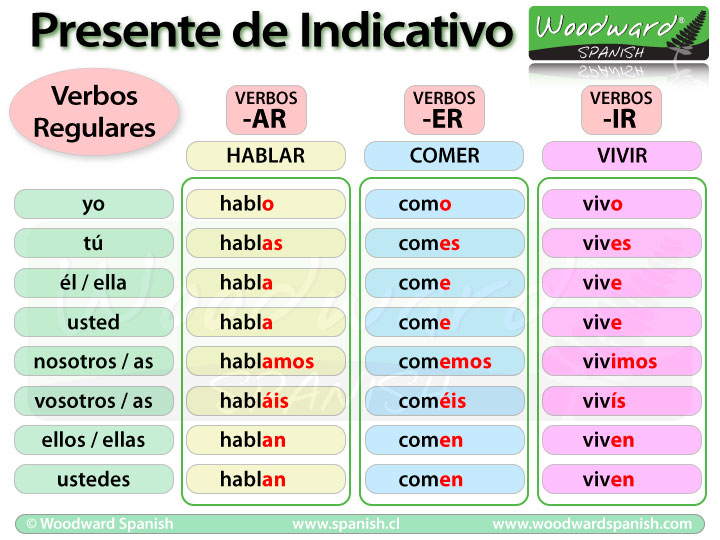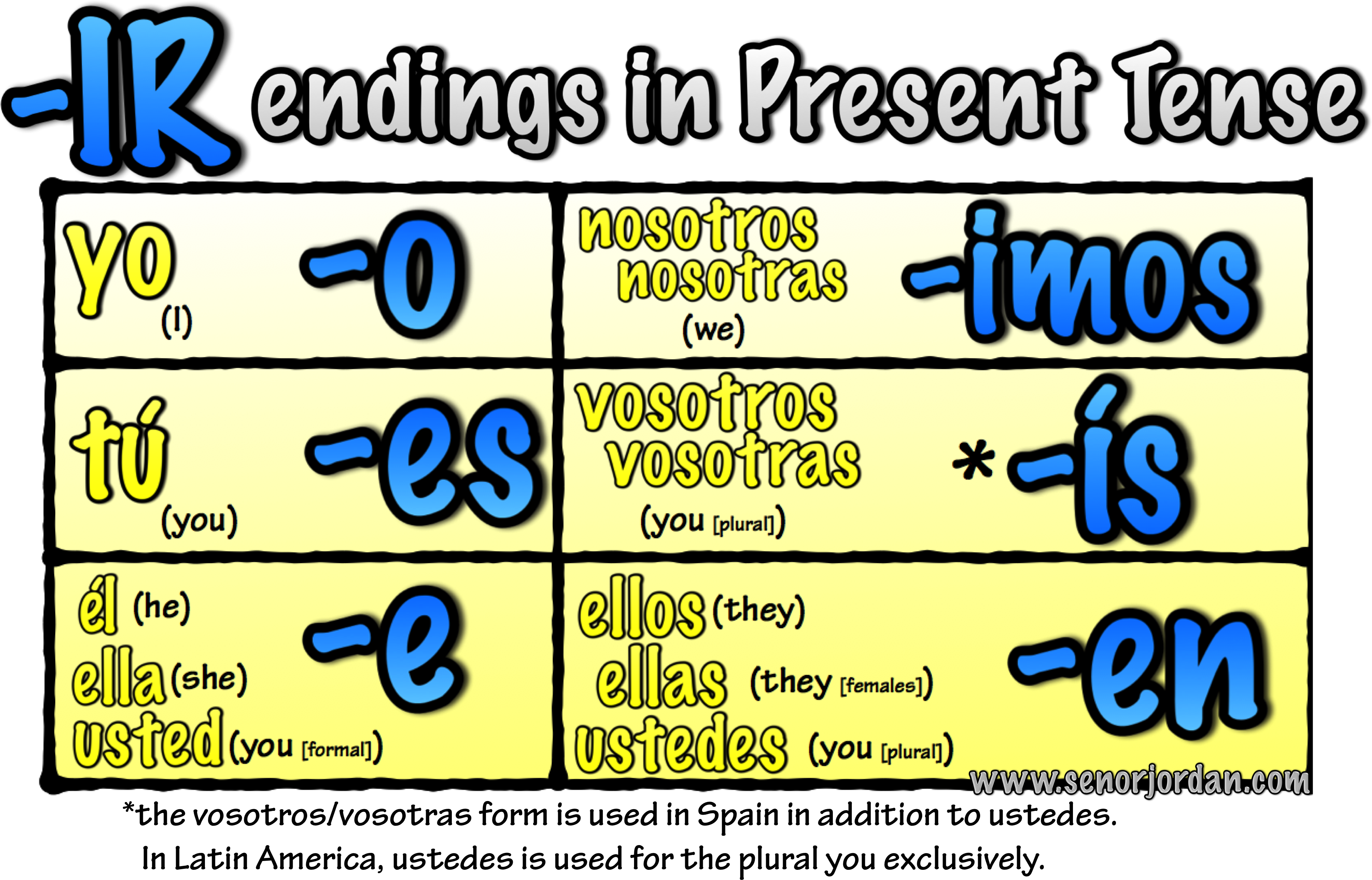
Present Tense in Spanish
Spanish Grammar Rules: El Presente Indicativ
In Spanish, verbs are classified into three types.
- Verbs ending in -AR,
- Verbs ending in -ER
- Verbs ending in -IR.
Spanish Regular Verbs in Present Tense
With regular verbs in Spanish, only the ending part of that verb (the
-ar,
-er or
-ir part) changes depending on who does the action. However, unlike English, there is a different ending for each subject (pronoun).
To begin, we will show you how to conjugate the verb in the present tense:
(Notice how the part of the verb in red is the part that changes)

Before you continue reading, make sure you know about
Subject Pronouns in Spanish (yo, tú, él etc.).
If you have the verb
Hablar (to speak) and you want to say “I speak”. You just remove the last two letters of the verb (in this case remove the
-ar) and add the letter -O to the end to create the conjugated verb
Hablo which means “I speak”.
Another example: if you want to say “They eat”, we take the original verb, in this case
Comer, we remove the ending (
-er) and then add -EN to the end (because
ellos = they). We now have
Comen (they eat).
You will notice that certain verb endings are repeated. For example for YO (I) we take off the ending for all regular verbs and add the -O to the root (main part) of the verb.
Also see how the only difference between -ER verbs and -IR verb endings is when we use
nosotros (we) and
vosotros (you/plural/informal).
The subject pronoun (yo, tú, nosotros etc.) is often omitted before the verb since we normally know who the subject (the person doing the action) is because of the verb’s ending.
For example: If you say “Hablamos español” (we speak Spanish). You don’t need to put the pronoun
nosotros before the verb because we know that when we say
hablamos, it refers to
nosotros (we). So often you will hear or just read “Hablamos español” without the pronoun
nosotros.

Spanish Irregular Verbs in Present Tense
The following verbs are only irregular in the first person (singular). The rest of the conjugations are as normal (see regular verbs above).
I.- First Person Verbs ending in -Y
The following verbs are a part of this group:
Estar (to be) –
Dar (to give)
| Subject |
Estar |
| Yo |
estoy |
| Tú |
estás |
| Él |
está |
| Ella |
está |
| Usted |
está |
| Nosotros / Nosotras |
estamos |
| Vosotros / Vosotras |
estáis |
| Ellos / Ellas |
están |
| Ustedes |
están |
- Yo estoy feliz. (I am happy)
- Yo estoy en mi casa. (I’m at home)
- Yo doy propinas (I give tips).
II.- First Person Verbs ending in -GO
The following verbs are a part of this group:
Hacer (to do) –
Poner (to put) –
Salir (to go out) –
Valer (to cost/be worth)
| Subject |
Hacer |
| Yo |
hago |
| Tú |
haces |
| Él |
hace |
| Ella |
hace |
| Usted |
hace |
| Nosotros / Nosotras |
hacemos |
| Vosotros / Vosotras |
hacéis |
| Ellos / Ellas |
hacen |
| Ustedes |
hacen |
- Yo hago mis tareas (I do my homework).
- Yo pongo la leche en el refrigerador.
- Yo salgo con mis amigos. (I go out with my friends)
- Yo valgo mucho (I’m worth it)
III.- First Person Verbs ending in -ZCO
Verbs that end in
-cir and
-cer change to
-zco in third person. The following verbs are a part of this group:
Conducir(to drive) –
Conocer (to know) –
Traducir (to translate)
| Subject |
Conducir |
| Yo |
conduzco |
| Tú |
conduces |
| Él |
conduce |
| Ella |
conduce |
| Usted |
conduce |
| Nosotros / Nosotras |
conducimos |
| Vosotros / Vosotras |
conducís |
| Ellos / Ellas |
conducen |
| Ustedes |
conducen |
- Yo conduzco mi coche. (I drive my car)
- Yo conozco a muchas personas. (I know many people)
- Yo traduzco canciones. (I translate songs)
Remember these verbs are only irregular in the first person (singular), the rest of the verb has the same rules as regular present tense conjugations.

Spanish Verbs that have Stem Changes
There are four types of verbs where the stem of the verb is irregular and changes. In the present tense these are verbs that change their stem from O to UE, from U to UE, E to IE, and E to I. Note that this stem change does
nothappen when the verb is for
nosotros o
vosotros (these maintain the original stem of the verb).
I.- Stem changes from O to UE
The letter “
O” in the stem of the infinitive verb changes to “
UE” in the conjugations.
| Subject |
Almorzar |
| Yo |
Almuerzo |
| Tú |
Almuerzas |
| Él |
Almuerza |
| Ella |
Almuerza |
| Usted |
Almuerza |
| Nosotros / Nosotras |
Almorzamos |
| Vosotros / Vosotras |
Almorzáis |
| Ellos / Ellas |
Almuerzan |
| Ustedes |
Almuerzan |
- Yo almuerzo con mis amigos. (I have lunch with my friends)
- Tú almuerzas todos los días en un restaurante. (You have lunch in a restaurant every day)
- Ellos almuerzan comida chilena. (They have Chilean food for lunch)
II.- Stem changes from E to IE
The letter “
E” in the stem of the infinitive verb changes to “
IE” in the conjugations.
| Subject |
Sentir |
| Yo |
siento |
| Tú |
sientes |
| Él |
siente |
| Ella |
siente |
| Usted |
siente |
| Nosotros / Nosotras |
sentimos |
| Vosotros / Vosotras |
sentís |
| Ellos / Ellas |
sienten |
| Ustedes |
sienten |
- Ellos sienten frío. (She feels cold)
- Tú sientes un dolor de cabeza. (You have a headache)
- Él siente una presencia. (He feels a presence)
III.- Stem changes from E to I
The letter “
E” in the stem of the infinitive verb changes to “
I” in the conjugations.
| Subject |
Pedir |
| Yo |
pido |
| Tú |
pides |
| Él |
pide |
| Ella |
pide |
| Usted |
pide |
| Nosotros / Nosotras |
pedimos |
| Vosotros / Vosotras |
pedís |
| Ellos / Ellas |
piden |
| Ustedes |
piden |
- Yo pido una bebida. (I ask for a drink)
- Usted pide un vaso de agua. (You ask for a glass of water)
- El animador pide un aplauso para el artista. (The presenter asks for applause for the artist)
IV.- Stem changes from U to UE
The letter “
U” in the stem of the infinitive verb changes to “
UE” in the conjugations. Note that the verb
Jugar is the only verb that is irregular in this way.
| Subject |
Jugar |
| Yo |
juego |
| Tú |
juegas |
| Él |
juega |
| Ella |
juega |
| Usted |
juega |
| Nosotros / Nosotras |
jugamos |
| Vosotros / Vosotras |
jugáis |
| Ellos / Ellas |
juegan |
| Ustedes |
juegan |
- Yo juego en mi pieza. (I play in my room)
- Tú juegas fútbol. (You play football)
- Usted juega baloncesto. (You play basketball)
]]>

 Before you continue reading, make sure you know about Subject Pronouns in Spanish (yo, tú, él etc.).
If you have the verb Hablar (to speak) and you want to say “I speak”. You just remove the last two letters of the verb (in this case remove the -ar) and add the letter -O to the end to create the conjugated verb Hablo which means “I speak”.
Another example: if you want to say “They eat”, we take the original verb, in this case Comer, we remove the ending (-er) and then add -EN to the end (because ellos = they). We now have Comen (they eat).
You will notice that certain verb endings are repeated. For example for YO (I) we take off the ending for all regular verbs and add the -O to the root (main part) of the verb.
Also see how the only difference between -ER verbs and -IR verb endings is when we use nosotros (we) andvosotros (you/plural/informal).
The subject pronoun (yo, tú, nosotros etc.) is often omitted before the verb since we normally know who the subject (the person doing the action) is because of the verb’s ending.
For example: If you say “Hablamos español” (we speak Spanish). You don’t need to put the pronoun nosotros before the verb because we know that when we say hablamos, it refers to nosotros (we). So often you will hear or just read “Hablamos español” without the pronoun nosotros.
Before you continue reading, make sure you know about Subject Pronouns in Spanish (yo, tú, él etc.).
If you have the verb Hablar (to speak) and you want to say “I speak”. You just remove the last two letters of the verb (in this case remove the -ar) and add the letter -O to the end to create the conjugated verb Hablo which means “I speak”.
Another example: if you want to say “They eat”, we take the original verb, in this case Comer, we remove the ending (-er) and then add -EN to the end (because ellos = they). We now have Comen (they eat).
You will notice that certain verb endings are repeated. For example for YO (I) we take off the ending for all regular verbs and add the -O to the root (main part) of the verb.
Also see how the only difference between -ER verbs and -IR verb endings is when we use nosotros (we) andvosotros (you/plural/informal).
The subject pronoun (yo, tú, nosotros etc.) is often omitted before the verb since we normally know who the subject (the person doing the action) is because of the verb’s ending.
For example: If you say “Hablamos español” (we speak Spanish). You don’t need to put the pronoun nosotros before the verb because we know that when we say hablamos, it refers to nosotros (we). So often you will hear or just read “Hablamos español” without the pronoun nosotros.


